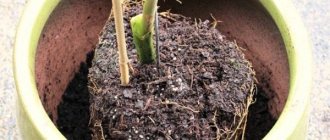When it is necessary?
The root system of a lemon is limited by the size of the container in which it is planted. In order for it to grow and bear fruit normally, regular replanting is necessary.
Frequency depends on the age of the tree:
- 1-2 year olds – replanting is not recommended;
- 2-3 year old plants – twice a year;
- 3-4 year olds – once a year;
- 4-7 year olds – once every two years;
- Over 10 years old - transplant every 9-10 years.
transplants may be necessary . They are carried out in the following cases:
- The size of the pot was chosen incorrectly and the soil began to turn sour. The plant must be transplanted into new soil regardless of the time of year, otherwise it will die.
- Buying a plant in a small pot. This is especially necessary when roots are sticking out of the drainage hole, which indicates a lack of space for their growth. If you do not transplant such a specimen into a spacious container, the lemon will stop growing and die.
- Roots are visible around the trunk. This means that the root system has mastered the space of the pot and there is not enough space for further growth.
- Reducing the number of fruits produced. The plant looks healthy, but the flowers do not set. This means the soil is depleted and needs to be replaced.
- A putrid smell is felt from the pot, fleas have appeared - evidence of souring, rotting of the roots.
Before transplanting, evaluate the soil clod. If it is not completely entangled in roots, refuse to transship it - the plant has not yet completely mastered the old soil, the roots will become exposed and suffer.
Replanting lemons in the presence of pests
Frequent parasites on the plant are turtles and spider mites. Places of accumulation are not only the above-ground part of the plant, but also the soil. Replacing the pot and soil is a mandatory procedure. Algorithm of actions:
- The plant is removed from the pot.
- Place in a large container with water.
- They completely inspect the tree, wash off all insects from the crown with laundry soap, and from the trunk and branches using a toothbrush.
- Completely remove any remaining soil from the root. If there are damaged areas, they are cut off.
The pot is subjected to heat treatment, the old soil is thrown away.
Tips for choosing cookware
- Wrap a white, translucent pot with thick cloth, otherwise the soil will become overgrown with moss and the plant will suffer.
- Before using a ceramic pot, soak it in water for 2-3 hours to moisten it and prevent it from drawing water from the soil.
- The plastic container does not require additional processing. But the drainage layer in it should be larger to avoid waterlogging. Clay absorbs excess liquid, but plastic does not.
- Wooden tubs recommended for tall specimens should be made of pine or oak. Other types of wood will rot at high speed, and you will have to replant at the wrong time. The tub is fired from the inside to form a layer of charcoal on the inner surface. It will disinfect the container and at the same time increase its resistance to rotting.
How to replant a lemon correctly
In order for the citrus plant to quickly adapt and begin to develop confidently, they adhere to generally accepted rules for choosing a new container and preparing the soil.
Choosing a pot
A container made of any material is suitable for lemon:
- plastic;
- ceramics;
- tree.
Each material from which lemon pots are made has advantages and disadvantages. Clay containers are convenient due to their ability to absorb excess moisture. Before transplanting, the ceramic pot is soaked in water for several hours so that the material is saturated with moisture and does not quickly dry out the soil. More drainage is placed in a plastic container - up to one third or even half of the volume. White plastic containers are covered with dark cloth or paper on top. For adult plants from 1.5 to 2.5 m, comfortable wooden tubs made of oak or pine are often chosen, which are fired before use to disinfect the material.
Adult lemons take root well and develop in cone-shaped high pots, where the lower part is narrowed and the edges are wide. Each container is equipped with a high tray. A mandatory requirement for lemon pots is the presence of large drainage holes. Hanging pots are unacceptable for the culture; it is better not to place even seedlings in this type of pot.
Growing young lemons are replanted regularly, each time the next pot is chosen a little larger than the previous one. Small containers for transplanting 3-5-year-old trees are increased in volume by 3-4 cm. Tubs with adult plants can be chosen larger, up to 10 cm. Then the fruit-bearing plant is constantly kept in a container of the same volume.
Soil preparation
Special soil for lemon is sold in gardening stores. You can also make your own substrate from garden or turf soil, humus and sand in a ratio of 3:1:1. Complex fertilizer is added to the mixture. A plant in such a substrate does not require feeding for the first year. Only in the second year are complex mineral preparations for citrus fruits used.
The substrate for transplantation can be composed in different versions:
- 2 parts chernozem or 1 part local clay soil;
- 1 part each of turf soil, humus or peat, sand.
When replanting, complex fertilizers with nitrogen and phosphorus are also applied. During transplantation and in other cases, do not use preparations containing chlorine to feed lemons.
The drainage holes in the pot are covered with ceramic fragments placed diagonally so that they do not completely cover the container. Then the large fractions are laid, with the small ones on top. Lemon must have drainage:
- usually large or medium expanded clay is used below;
- fragments from broken ceramics in a layer of up to 2 cm;
- then sprinkle a 2-2.5 cm layer of sand on top;
- instead of sand, peat, moss or dry humus are also placed on top of drainage materials;
- lay a thick layer of drainage in plastic pots - up to one third or even half the height of the container.
Some citrus growers have a different opinion and, when replanting, instead of drainage, mix the substrate with some sand, pebbles, and other drainage material:
- perlite;
- zeolite.
Also add a handful of Osmokot long-acting fertilizer.
There is a mention in the literature that clay soil cannot be used for lemon. At the same time, citrus seedlings from abroad are very often placed in a substrate based on clay mixed with non-acidic peat.
Attention! It is preferable that the new lemon container be larger in diameter rather than in height.
Transfer rules
Beginners are afraid of damaging the lemon roots when transshipping or replacing the substrate. But the plant is strong and is not afraid of replanting, including freeing the roots from the old soil. It takes root well in a new substrate if everything is done according to the rules.
Stages of lemon transplantation:
- Water the container with lemon generously; begin to remove the plant 12-17 minutes after watering, when the entire earthen ball is thoroughly wet.
- A layer of substrate is poured onto a layer of drainage and sand so that the lump or roots themselves fit completely into the container.
- Lemon roots are removed from the old container and, if damaged, dark, sometimes with mucus, easily detached bark, shoots are seen, cut off, the sections are treated with some kind of growth stimulant and placed on new soil.
- The root collar should be slightly deepened in relation to the edges of the pot or be level with the border, but not covered with soil.
- When planting, make sure that the trunk is vertical and leveled as much as possible.
- The soil is compacted and watered with settled warm water.
Immediately after planting, for better adaptation, the top layer of soil is sprayed with Zircon and covered with a plastic bag for 4-6 days.
The plant definitely needs to be replanted with replacement of the substrate and sanitary cleaning of the roots if:
- the leaves show signs of wilting;
- The pot smells unpleasantly of rot.
Perhaps due to overflow, putrefactive processes began. The lemon is placed with its roots in a spacious basin, freed from the substrate, washed, the diseased areas are cut off, and the sections are sprinkled with crushed coal, Kornevin or other growth stimulant. The pot is either changed or thoroughly disinfected. During such a transplant, be sure to cut off some of the branches so that the weakened roots can feed the remaining shoots.
Advice! Before replanting, a mark is attached to the south side of the lemon to point the plant in the same direction.
What soil should I plant in?
Special soil can be found in the store. If you can’t buy it, make a mixture of soil (2 parts), leaf turf (1 part), sand (1 part), humus (1 part).
Before planting, sterilize it using the water bath method . Place the container with soil in another, larger one, filled with water. Heat for an hour and a half.
Do not use soil from your garden. It is not loose enough and too sour. Lemon will not bloom or bear fruit.
The nutrients contained in the soil will last the plant for six months, then start feeding it with a special fertilizer for lemons.
We talked about how to prepare the ideal soil mixture for lemon at home here.
Procedure technology
Transplanting a homemade lemon consists of the following steps:
- Take a pot of suitable size.
- Drainage is laid at the bottom with a layer of 3 cm.
- To provide additional nutrition, a layer of peat 2 cm thick is laid on top of the drainage.
- Carefully remove the lemon from the old pot, preventing the earthen lump from falling off.
- Dry and damaged roots are cut off and treated with Kornevin.
- Place the lemon in the center of the new pot so that the root collar is located slightly below the edge of the container.
- Fill with prepared soil mixture and compact it.
- Water the seedling generously and sprinkle with Zircon solution.
Rules
How to properly transplant a lemon into another pot at home? Transplanting a lemon tree into a new pot is carried out as follows.
- Cover the drainage hole with a convex shard, and pour a layer of drainage mixture on it of at least 5 centimeters. Then add a small layer of soil.
- Remove the tree from the pot, being careful not to destroy the lump of soil. If the soil falls off the roots, the plant will become sick, as it will not be able to immediately adapt to new conditions.
- Cut off the dried roots with a sharp knife or scissors. Do not tug or untangle them.
- Place the tree in the center of the pot at the same level as the old one.
- Fill in the remaining space and compact the soil.
- Do not fill the root collar. The layer of soil above the roots should be no more than 5 centimeters.
- Compact the soil thoroughly, avoiding the formation of voids.
- Water the lemon and place it in a slightly shaded place.
- After a few days, place the plant in the same place where it was previously.
Supplement the drainage with a two-centimeter layer of peat, moss or crushed dry manure. This technique will additionally protect the plant from waterlogging and provide it with nutrition.
You can preserve as much earthen lump as possible if you do not remove the tree from the pot, but carefully cut it into two halves and remove it from the roots.
Place the tree with the same side to the sun as it was located before. Feeding and watering the lemon tree after transplanting.
The first feeding is carried out no earlier than a month later. The composition of the fertilizer must include mineral and organic substances. Read about how and what to feed lemon at home.
Even careful transfer to a new pot is a real stress for the tree . To help it get used to new conditions faster, treat it with Zircon.
Watering is done with settled or frozen water. Every day at high air temperatures and low humidity, in damp, cool weather - once every two to three days, in winter - once a week.
When watering, try not to get on the root collar. Pour water into the edge of the pot. Water the lemon with exclusively warm water for the first two weeks.
The amount of water is determined by the liquid poured into the pan. A day after watering, drain the water from the pan into the pot.
In addition to watering, homemade lemons need to be sprayed . Only soft water is suitable for spraying. Spraying is not carried out in winter (you will find rules for caring for homemade lemons in winter in a separate article).
Step-by-step instruction
Transplanting a young indoor lemon is an important step in caring for such a plant. Therefore, step-by-step instructions with key requirements and rules are something that the gardener needs to consider in detail, especially if a novice specialist takes on the job. What do the instructions for replanting indoor lemon include:
- First, ensure there is drainage. Place a rounded shard at the bottom of the flowerpot and fill it with drainage mixture. Thus, moisture will not stagnate in it;
- then a small layer of soil is laid out in the pot;
- the plant is removed from the old container. It is not recommended to completely clear the root system from the earthen ball, otherwise you may damage it and the plant will begin to hurt after replanting. If desired, remove a little of the top layer of soil, but no more;
- If you notice dry or broken roots during a lemon transplant, they must be carefully cut off;
- place the plant in a new flowerpot and then cover the roots with soil;
- also try to compact the soil by gradually adding fresh layers of substrate;
- root collar - the part of the plant that is located between the roots and the main stems, should not be covered with soil;
- when the key excavation work has been completed, be sure to water the plant, and very thoroughly;
- For the first time after transplantation, indoor lemons are not recommended to be exposed to the sun. Place the flowerpot with the plant in a shaded place, so it will much more easily withstand the stressful situation associated with replanting;
- After a few days, the indoor lemon can be placed in a well-lit area of your home. The main thing is to follow the basic rules of care and monitor the condition of the plant.
Is it possible to prune a transplanted tree? Many gardeners are interested in this issue. In fact, such a procedure is not necessary. But if, during the process of replanting the plant, you notice that the roots are dry or broken in places, it is recommended not only to remove them, but also to partially trim the plant from above. You will not bring any harm to the tree, quite the opposite: such a procedure will give a new impetus, which will favorably influence the activity of the plant’s development and the formation of young fruits on it.
It doesn’t matter where exactly you decide to grow indoor lemon or another plant similar to it: in a house or apartment. Here it is important to approach the purchase of a pot and the choice of land with all seriousness. Pay special attention to the step-by-step instructions for planting this tree - and soon it will delight you with its rapid growth rate and many ovaries on the stems. Indoor lemons are not particularly fussy to care for, so you shouldn’t have any problems growing them.
Land quality
After preparation, before planting, the quality of the resulting land for lemons is checked. Using litmus paper, check the pH level. A lump of earth is moistened with filtered or distilled water, and litmus paper is tightly applied to it. Yellow and green color of the paper indicates a pH level of 6-7, red indicates high acidity, blue indicates an alkaline environment.
To check for the presence of oil impurities in the mixture, a small part of it is sent into water and mixed.
After the earth settles at the bottom, the surface of the water is examined. If there are no greasy spots on the surface, there are no impurities. Studying the mineral composition allows you to choose the right soil for lemons.
Optimal soil environment
The most optimal soil medium in a pot for lemon is considered to be a combination of the following fractions::
- A drainage layer of 2 cm is placed on the bottom of the pot.
- 2-2.5 cm of river sand is poured on top. The sand needs to be steamed in advance.
- The last layer and the most basic one is the soil mixture.
To make your task easier, you can purchase ready-made soil for citrus plants. To prepare such soil yourself, you will need to mix in equal proportions:
- forest humus or manure;
- sifted river sand;
- disinfected prepared soil.
Recommendations for saving a plant if it does not take root
If the plant does not take root, then any growth stimulants will help save the situation. For good rooting, use Kornevin during planting . If the drug has not been used, then water the plant with Zircon after transplantation.
To help the plant take root in a new pot, it is important to find out the reasons why it does not take root and eliminate them. The plant may need to be replanted again.
Replanting a lemon tree is not as difficult as it seems at first glance. It is important in this process to take into account not only the growth phase of the plant into which it can be replanted, but also other requirements, for example, the size of the pot, the quality of the soil. During the replanting process, it is important to carefully handle the root system of the plant : remove rotten and damaged roots, and treat the root system with a growth stimulator.
Choosing a pot for your lemon
Any material is suitable - plastic, ceramics, wood. It is only important to ensure good drainage. For mature plants, wooden cone-shaped tubs are desirable.
When transshipping, the size of the pot should remain almost the same: increase the pot by no more than 2-4 cm, the tub by 4-8 cm in diameter.
A very important quality of a lemon pot is the ability to check whether water is stagnating at the bottom. Therefore, a pot with a flat base is definitely preferable to a flowerpot.
In the photo there is a flowerpot
Stylistically, lemons look very appropriate in ceramic pots, white or terracotta, with or without a pattern. However, you need to take into account in which pots the flowers standing next to each other grow, so that the composition looks harmonious.
Lemon propagation methods
A seed from the fruit is dropped into the soil for lemons to a depth of no more than 1-1.5 cm; It will in no way resemble a varietal indoor lemon. You can use the bone of a varietal compact tree. But in this case, a plant can also be obtained that has not inherited the characteristics of the mother tree. Germinating a lemon seed is very simple: The most common methods of lemon propagation are: seed propagation, grafting and cuttings. Any variety of lemon can be propagated by seeds. Most often, they take a seed from a purchased ripe fruit and plant it in the ground.
- The soil is periodically moistened; there is no need to cover the crops with film.
Up to 100% of large seeds from ripe fruits germinate. Another disadvantage of seed propagation is that the seedling will not bloom earlier than after 10 years. Therefore, lemon seedlings are grafted with cuttings and eyes from a fruiting varietal specimen.
Grafting is another method of propagation that allows you to obtain varietal lemons on wildflower roots. Cuttings are the most convenient method of propagation. Cuttings of varietal fruit-bearing lemon are harvested during pruning and rooted in the ground. Such plants bloom already 2-3 years after rooting. They completely retain the varietal characteristics of the mother plant. A lemon grown from a cutting does not require grafting.
Source of the article: https://florist-club.com/limon/peresadka.html
Is it possible to replant a flowering lemon with fruits?
The optimal time for transplanting a lemon at home is a relative period of rest, when there are no flowers or fruits on the plant. But, firstly, there are remontant varieties that bloom and bear fruit throughout the year. And, secondly, sometimes a tree needs emergency help. In these cases, the restrictions can be neglected.
A healthy plant is transferred by transshipment in order to minimally disturb the root system. If you act carefully, then a blooming lemon can tolerate this procedure quite easily; the most that can happen is that some of the flowers will fall off. For a healthy fruit-bearing lemon, transplanting into fertile soil also most often does without negative consequences. Usually the growing season resumes quickly, and fruit ripening occurs faster.
Transfer
If the plant has been attacked by pests or is affected by any disease, then it is necessary to cut off damaged roots and branches and completely remove the old soil. After this, the plant is treated with disinfectants and transplanted into new soil. In this case, after transplantation, the flowers and fruits are completely removed to make it easier for the plant to adapt.
Choosing the right new pot
A high-quality transplant of a lemon tree is impossible without purchasing a new spacious flowerpot. It is selected according to several parameters:
- Material of manufacture. The best pot material for a lemon tree is clay. It is very porous, allowing air and small amounts of water to pass through. The earthen lump in such a pot dries evenly, preventing moisture from stagnating in the soil. This is very beneficial for the lemon root system and prevents rotting. Other materials (glass, plastic) do not have such properties. When using them, it is necessary to regularly check the soil moisture and carefully monitor watering;
- Shape and size. The lemon tree pot should not be too high. It is desirable that its height be equal to its diameter. In a deeper pot, there is a high probability of water stagnation in the lower layers of the soil, which leads to root rot. The lemon is transplanted into a larger pot. But it shouldn't be too big. It must be remembered that until the roots of the lemon tree grow to the walls of the pot, it will not bloom. Therefore, a new pot is taken 1-2 cm wider than the previous one.
Growing lemon from seed at home
Before planting lemon seeds, choose shallow, wide containers with mandatory drainage holes. A 2-centimeter layer of fine expanded clay or vermiculite is poured onto the bottom of a pot or other container so that all excess moisture, dangerous for the delicate roots, flowing down, does not linger and leaves the soil in time.
You can make your own soil for growing lemon seeds at home by mixing garden soil, humus and sand. It is useful to add a little crushed charcoal to such a substrate, which will reduce the risk of developing bacterial infections. If you don’t have the necessary ingredients on hand, a ready-made substrate for citrus fruits is suitable, which can be easily purchased at a specialty store.
All preparatory work has been completed. Now it's time to start sowing. How to grow lemon from a seed at home?
The seeds are planted in moist soil to a depth of about two centimeters. You can plant several seeds in one container at once. Since the seedlings wait for the first transplant when they have 3-4 true leaves, the plants will not interfere with each other.
The containers are placed in a greenhouse or placed in a warm place, first covered with a bag or film. Do not forget that all citrus fruits are heat-loving, so growing lemon from a seed at home is possible only if a certain temperature regime is observed.
The seedlings will not begin to grow if the air and soil in the room are colder than +18 °C. It is optimal if seed germination and subsequent growth take place at a temperature of 22 to 25 °C, with constantly high humidity, absence of drafts and other negative factors. Following simple rules on how to grow a lemon from a seed allows you to get friendly, strong shoots.
Is it possible to carry out the procedure during flowering?
When transplanting a lemon tree, it is important to focus on the stage of plant development. If we are talking about a planned transplant, then it should be carried out during the growth phase, but in no case should you choose the flowering time of the tree for this.
During flowering, the root system is most vulnerable, since all nutrients go to the top of the plant, forming ovaries and flowers, and then fruits. In order for a plant to take root well, it needs to spend considerable effort on this process. This leads to the death of the ovaries and, as a consequence, the lack of fruiting.











